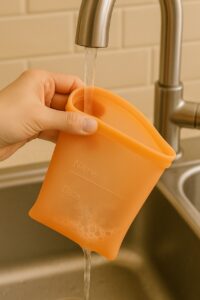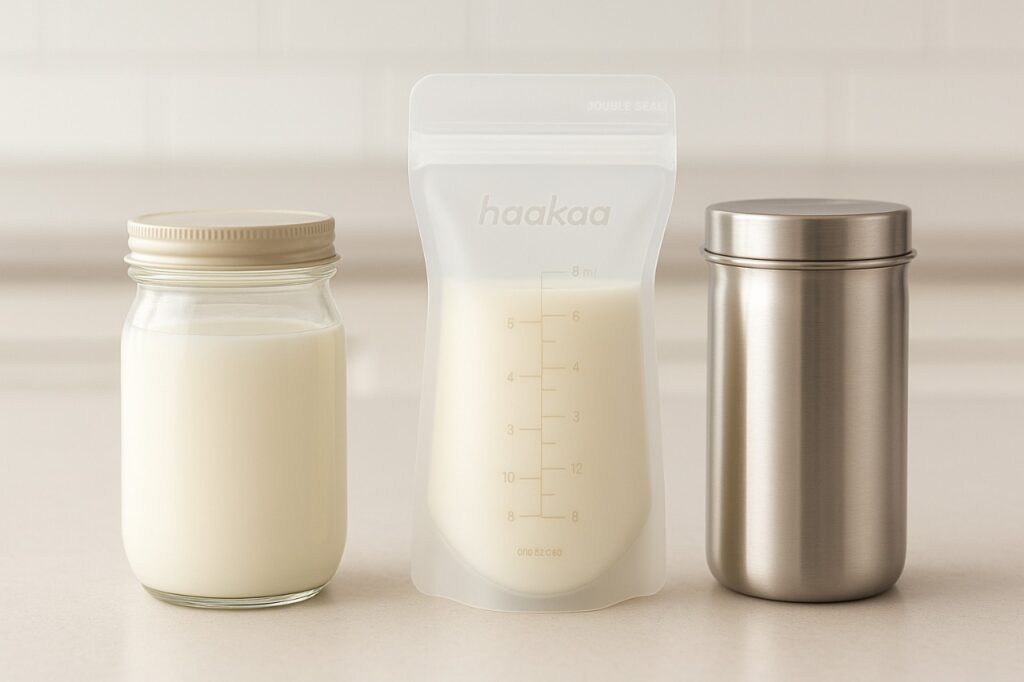Why Go Non-Plastic for Breast Milk Storage
More U.S. moms are now turning away from plastic when it comes to breast milk storage — and for good reason. Even BPA-free plastics can sometimes release microplastics or chemical traces when exposed to heat or frequent freezing. Over time, these small exposures can affect both milk quality and overall safety.
Non-plastic alternatives like glass jars, silicone bags, and stainless steel containers are gaining popularity for being safer, reusable, and environmentally friendly. These materials protect your milk’s purity while reducing waste and chemical exposure.
👉 Read official AAP Guidelines on Safe Milk Storage for toxin-free container recommendations.
1. Glass Jars — The Classic, Safe Choice
Glass containers remain one of the most trusted options for breast milk storage. They’re 100% chemical-free, don’t absorb odors, and can handle both freezing and warming without risk of leaching.
Their only drawbacks are weight and fragility — but if handled carefully, glass jars can last for years and maintain absolute purity. Many parents prefer using small mason jars or baby food jars for easy portioning and labeling.
If you’re new to safe container choices, check our detailed guide:
👉 Best Milk Storage Containers: Glass vs. Plastic vs. Metal (Ultimate USA Buying Guide).
2. Silicone Breast Milk Bags — The Flexible, Reusable Upgrade
Silicone bags are a fantastic new solution for moms looking to avoid single-use plastics. Made from food-grade, BPA-free silicone, they’re soft, durable, and safe for freezing and thawing.
They take up less space than bottles, are easy to clean, and can last through hundreds of uses — reducing both cost and waste. Unlike disposable plastic bags, they don’t crack or leak when frozen.
3. Stainless Steel Containers — Durable and Eco-Friendly
If you prefer something long-lasting and modern, stainless steel milk storage containers are an excellent choice. They’re lightweight, shatterproof, and completely resistant to staining or odor retention.
Stainless steel also cools faster than glass, helping milk reach safe storage temperatures more efficiently. Some U.S. brands even offer double-wall insulation for better preservation during transport.
For additional freezer organization ideas, explore our related guide on
👉 How to Organize Breast Milk in Freezer (Flat-Freezing & FIFO Guide).
Safety Tips for Non-Plastic Storage

- Always sterilize glass, silicone, or metal containers before first use.
- Avoid rapid temperature changes (like boiling glass directly from the freezer).
- Label every container with date and time for FIFO rotation.
- Clean silicone bags with mild soap and dry completely before reuse.
If you prefer reusable solutions, always check that materials are FDA-approved for infant milk storage.
👉 Review the FDA’s Food-Safe Materials Standards for safe, non-toxic options.
FAQ: Choosing Safe Non-Plastic Storage
Q1: Are silicone bags completely safe for milk storage?
Yes. High-quality, food-grade silicone bags are heat- and freeze-resistant, non-toxic, and reusable.
Q2: Can I freeze breast milk in glass jars?
Yes, just leave an inch of space at the top for milk expansion when freezing.
Q3: Is stainless steel safe for infants?
Absolutely. It’s one of the safest, most durable options for long-term use and won’t leach chemicals.
Conclusion: Choose Smart, Go Plastic-Free
Switching to non-plastic breast milk storage is a simple but powerful way to protect your baby’s health and reduce environmental waste.
Glass jars, silicone bags, and stainless steel containers each offer unique benefits—cleanliness, durability, and sustainability.
By investing in non-plastic solutions, you’re choosing both safety and sustainability, ensuring your baby’s milk stays pure and the planet stays clean.

